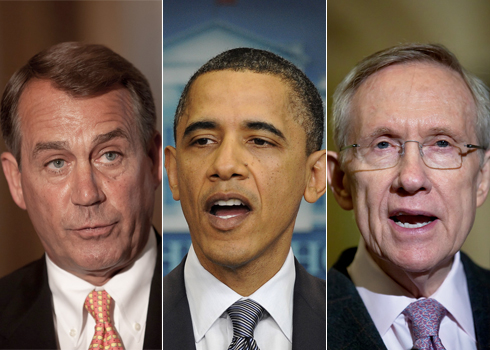With Congress careening towards a debt-ceiling deadline of Aug. 2 with no easy solution in sight, behind-the-scenes negotiations are beginning to focus on different trigger options that could break the partisan logjam and end the debt crisis before Washington plunges the country into default.
Even as both sides appeared to harden their positions publicly, Democratic and Republican aides have begun to discuss a variety of trigger options that could bridge the deep divide between the two parties, according to Democratic officials familiar with the negotiations.
Speaker John Boehner (R-OH) was scrambling Thursday evening to find enough Republicans to vote for his bill imposing a two-step process to raising the debt ceiling. Even if it passes, Senate Majority Leader Harry Reid has declared it dead on arrival in the Senate and has vowed to immediately kill it.
Democrats ardently oppose Boehner’s plan to raise the debt ceiling in two stages — once right away and another most likely in December. Both steps would include matching cuts in spending, $917 billion over 10 years in the first one, accompanying the $900 billion debt ceiling increase. But the second step could be far more difficult to reach because it promises to produce serious savings to entitlement programs such as Medicare and address tax reform, thorny issues Congress has failed to address for decades.
Democrats are also deriding the Boehner plan for its timing: the second step would come in late December, and would undoubtedly spur a debtmageddon redux crashing up against a Christmas deadline.
Senate Majority Leader Harry Reid (D-NV) is trying to round up 60 votes to pass his alternative proposal and avoid a filibuster, but so far has only reached an estimated 55. But Democratic officials argue that both the Reid and Boehner plans are fundamentally very similar. Both proposals do not include any revenues or tax increases and would produce roughly $1 trillion over the next decade with a plan for $1.5 trillion more in cuts hashed out by a bipartisan debt committee.
Democrats are dead set against Boehner’s short-term debt-ceiling extension and instead want to extend the borrowing authority through 2013, while Republicans oppose such a plan because it would give the President a “blank check” during the critical phase of the campaign season.
To reach a deal with Democrats, Republicans will have to move away from their insistence on revisiting the debt-ceiling debate before November 2012. Such a compromise would extend the nation’s borrowing limit until January 2013 and fold in the $1 trillion in cuts over ten years both Reid and Boehner agree should be made right away. Congress would face an end-of-the-year deadline to find another $1.5 trillion in cuts or else.
The “or else” would be a trigger imposing severe across-the-board spending cuts in domestic and defense programs and even possibly tax increases, if Congress fails to find the savings. The trigger would include a little something for everyone to resist and would, at least in theory, create enough incentive for Congress to find a solution.
Desperate budgetary times in the past have called for these same types of desperate budgetary measures with limited success. During President Ronald Reagan’s tenure, Congress passed the Gramm-Rudman-Hollings Balanced Budget Act in 1984, which included a trigger imposing draconian across-the-board spending cuts unless hard-and-fast deficit reduction goals were met.
But those the Gramm-Rudman backstop was only triggered twice in history, and one of those times was because of a clerical error in a bill. Instead, when Congress failed to reach the deficit-reduction goals in 1990, President George H.W. Bush caved on his no new taxes pledge and signed a bill that raised enough revenue to cover the shortfall.
Another simpler trigger, Democrats say, would simply impose the proposal put forward by Senate Minority Leader Mitch McConnell (R-KY), which would allow the President to raise the debt ceiling with Congress only able to disapprove of the move with a two-thirds majority vote in both chambers. McConnell would have a tough time opposing a plan he suggested such a few short weeks ago, Democrats argue.
But Democrats are tight-lipped about which version of a trigger they believe would attract the most support to ensure Congress get a bill to the President’s desk that he will sign by the Aug. 2 deadline. The only trigger Democrats would not accept, Democratic officials said, is the one Republicans are currently edging alarmingly close to setting off: damaging the already fragile economy.
Follow this reporter on Twitter: @susancrabtree









